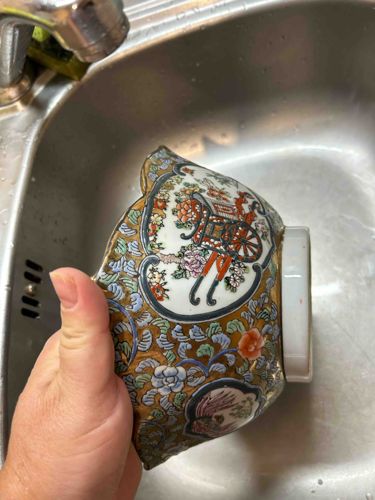
Japanese Imari-Style Porcelain Teacup or Bowl Fragment
This item appears to be a fragment of a ceramic vessel, likely a teacup or small bowl, crafted from fine porcelain. The primary decorative style is consistent with Japanese Imari ware, characterized by its vibrant color palette including rich iron red, cobalt blue, green, gold, and accented by black outlines. The fragment showcases intricate floral and foliate patterns covering much of its surface. A notable feature is a central medallion or cartouche, which depicts what appears to be a stylized wheel or carriage with floral elements. Another smaller, partially visible medallion is present towards the bottom of the fragment, also containing decorative motifs. The background features a dense, repeating pattern of intricate scrolling vines, leaves, and smaller flowers in blue, green, and iron red against a gold or gilded ground, suggesting a luxurious aesthetic. The reverse side of the fragment is predominantly white porcelain, with a visible rim from what was likely its foot or base, indicating the original item had a ring foot typical of Asian ceramics. The presence of a clean break suggests it was part of a larger, now-broken piece. The edges of the break are sharp and irregular, indicating significant damage. Despite the damage, the remaining decoration exhibits fine hand-painting and attention to detail, characteristic of quality craftsmanship. The gold accents show some wear or tarnishing in areas, consistent with age and use. The specific patterns and colors suggest a Meiji Era (1868-1912) or early 20th-century origin, though Imari styles have been produced for centuries. The visible white porcelain body and detailed enameling point to a high-quality ceramic production.
AI-Generated Appraisal Disclaimer
Estimated Value
$25-50
Basic Information
Category
Ceramics Fragment
Appraised On
December 18, 2025
Estimated Value
$25-50
Item Description
This item appears to be a fragment of a ceramic vessel, likely a teacup or small bowl, crafted from fine porcelain. The primary decorative style is consistent with Japanese Imari ware, characterized by its vibrant color palette including rich iron red, cobalt blue, green, gold, and accented by black outlines. The fragment showcases intricate floral and foliate patterns covering much of its surface. A notable feature is a central medallion or cartouche, which depicts what appears to be a stylized wheel or carriage with floral elements. Another smaller, partially visible medallion is present towards the bottom of the fragment, also containing decorative motifs. The background features a dense, repeating pattern of intricate scrolling vines, leaves, and smaller flowers in blue, green, and iron red against a gold or gilded ground, suggesting a luxurious aesthetic. The reverse side of the fragment is predominantly white porcelain, with a visible rim from what was likely its foot or base, indicating the original item had a ring foot typical of Asian ceramics. The presence of a clean break suggests it was part of a larger, now-broken piece. The edges of the break are sharp and irregular, indicating significant damage. Despite the damage, the remaining decoration exhibits fine hand-painting and attention to detail, characteristic of quality craftsmanship. The gold accents show some wear or tarnishing in areas, consistent with age and use. The specific patterns and colors suggest a Meiji Era (1868-1912) or early 20th-century origin, though Imari styles have been produced for centuries. The visible white porcelain body and detailed enameling point to a high-quality ceramic production.
Related Tags
Get Your Items Appraised
Instant estimates of your treasures with AI-powered instant appraisals